Research in Business: Social Networks vs Word-of-Mouth Analysis
VerifiedAdded on 2021/04/17
|6
|864
|58
Report
AI Summary
This report analyzes the impact of social networks versus traditional word-of-mouth (WOM) on consumer purchase decisions. The study investigates the shift from print culture to electronic communication and its effect on WOM. The research aims to compare the influence of social networks and traditional WOM, examining the reliability of social network recommendations. A deductive research approach is employed, utilizing a mixed methodology of quantitative and qualitative methods, including questionnaires, secondary data from journals, websites, and statistical analysis. The report identifies the issue of recognizing the intensity and nature of effect of traditional WOM and social networking (electronic word of mouth) on purchase decisions of consumers. The learner intends to gather primary along with secondary data to provide comparative examination of the effect of word of mouth and social networking.

Running head: RESEARCH IN BUSINESS
Research in Business
University Name
Student Name
Authors’ Note
Research in Business
University Name
Student Name
Authors’ Note
Paraphrase This Document
Need a fresh take? Get an instant paraphrase of this document with our AI Paraphraser
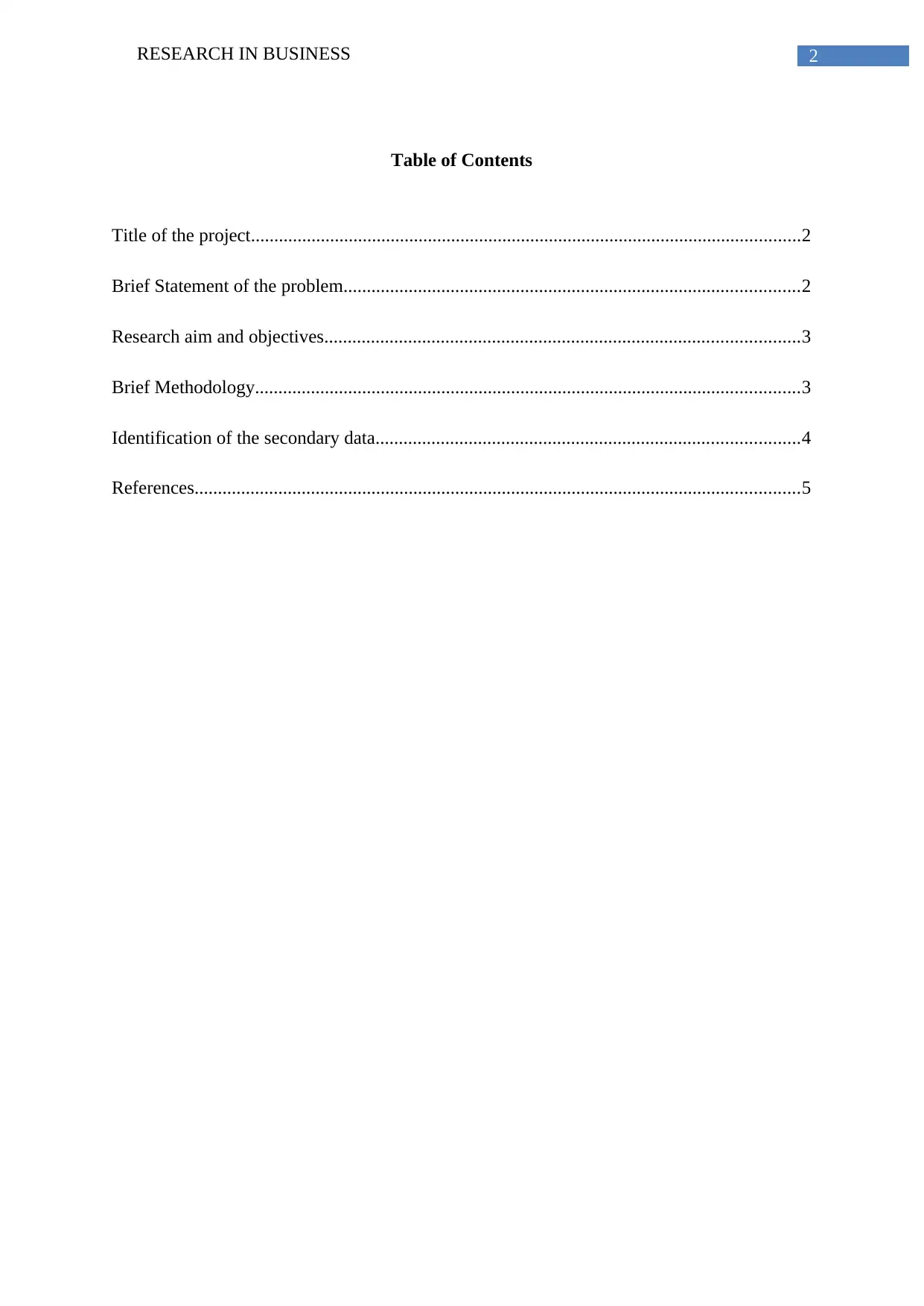
2RESEARCH IN BUSINESS
Table of Contents
Title of the project......................................................................................................................2
Brief Statement of the problem..................................................................................................2
Research aim and objectives......................................................................................................3
Brief Methodology.....................................................................................................................3
Identification of the secondary data...........................................................................................4
References..................................................................................................................................5
Table of Contents
Title of the project......................................................................................................................2
Brief Statement of the problem..................................................................................................2
Research aim and objectives......................................................................................................3
Brief Methodology.....................................................................................................................3
Identification of the secondary data...........................................................................................4
References..................................................................................................................................5
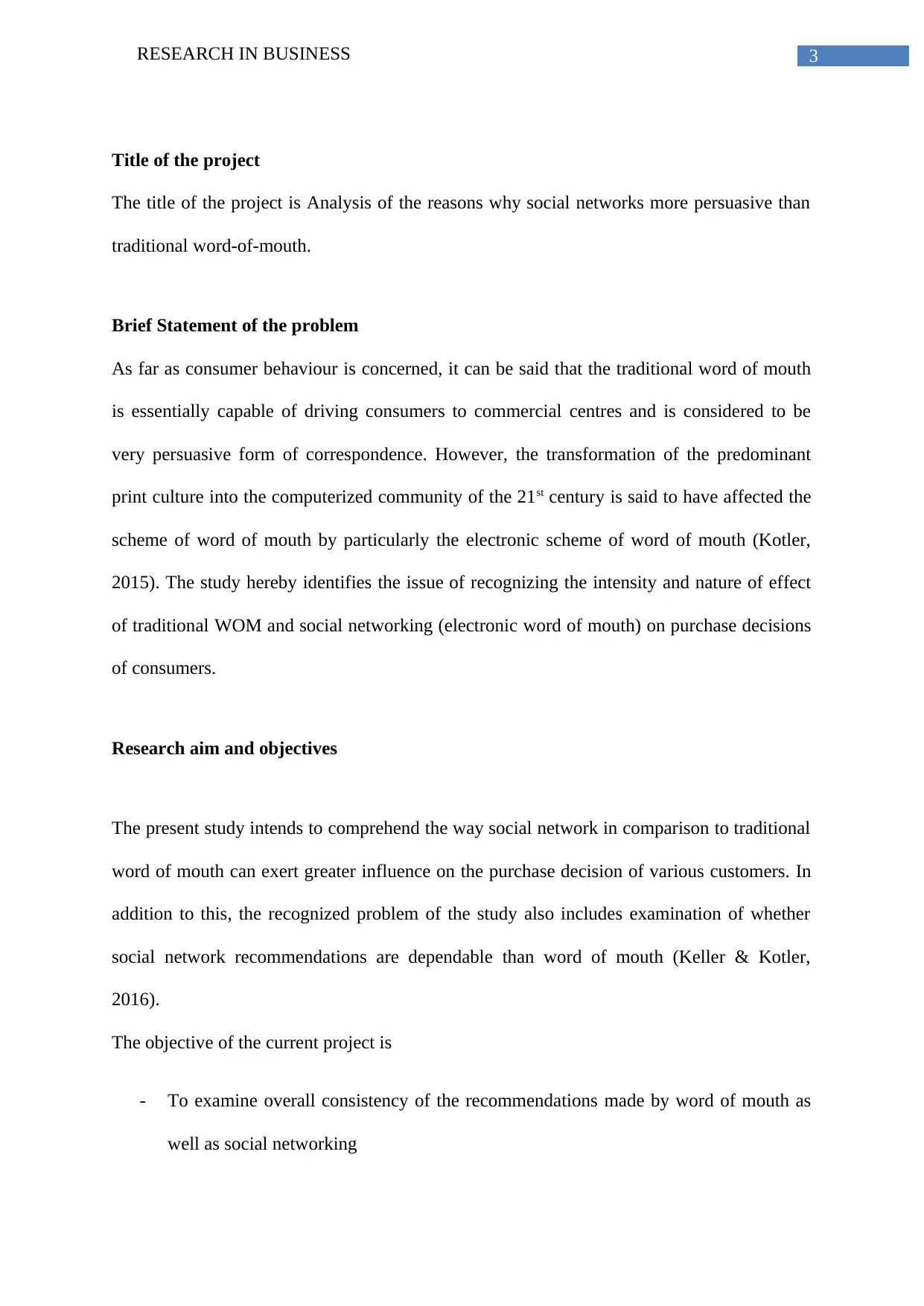
3RESEARCH IN BUSINESS
Title of the project
The title of the project is Analysis of the reasons why social networks more persuasive than
traditional word-of-mouth.
Brief Statement of the problem
As far as consumer behaviour is concerned, it can be said that the traditional word of mouth
is essentially capable of driving consumers to commercial centres and is considered to be
very persuasive form of correspondence. However, the transformation of the predominant
print culture into the computerized community of the 21st century is said to have affected the
scheme of word of mouth by particularly the electronic scheme of word of mouth (Kotler,
2015). The study hereby identifies the issue of recognizing the intensity and nature of effect
of traditional WOM and social networking (electronic word of mouth) on purchase decisions
of consumers.
Research aim and objectives
The present study intends to comprehend the way social network in comparison to traditional
word of mouth can exert greater influence on the purchase decision of various customers. In
addition to this, the recognized problem of the study also includes examination of whether
social network recommendations are dependable than word of mouth (Keller & Kotler,
2016).
The objective of the current project is
- To examine overall consistency of the recommendations made by word of mouth as
well as social networking
Title of the project
The title of the project is Analysis of the reasons why social networks more persuasive than
traditional word-of-mouth.
Brief Statement of the problem
As far as consumer behaviour is concerned, it can be said that the traditional word of mouth
is essentially capable of driving consumers to commercial centres and is considered to be
very persuasive form of correspondence. However, the transformation of the predominant
print culture into the computerized community of the 21st century is said to have affected the
scheme of word of mouth by particularly the electronic scheme of word of mouth (Kotler,
2015). The study hereby identifies the issue of recognizing the intensity and nature of effect
of traditional WOM and social networking (electronic word of mouth) on purchase decisions
of consumers.
Research aim and objectives
The present study intends to comprehend the way social network in comparison to traditional
word of mouth can exert greater influence on the purchase decision of various customers. In
addition to this, the recognized problem of the study also includes examination of whether
social network recommendations are dependable than word of mouth (Keller & Kotler,
2016).
The objective of the current project is
- To examine overall consistency of the recommendations made by word of mouth as
well as social networking
⊘ This is a preview!⊘
Do you want full access?
Subscribe today to unlock all pages.

Trusted by 1+ million students worldwide
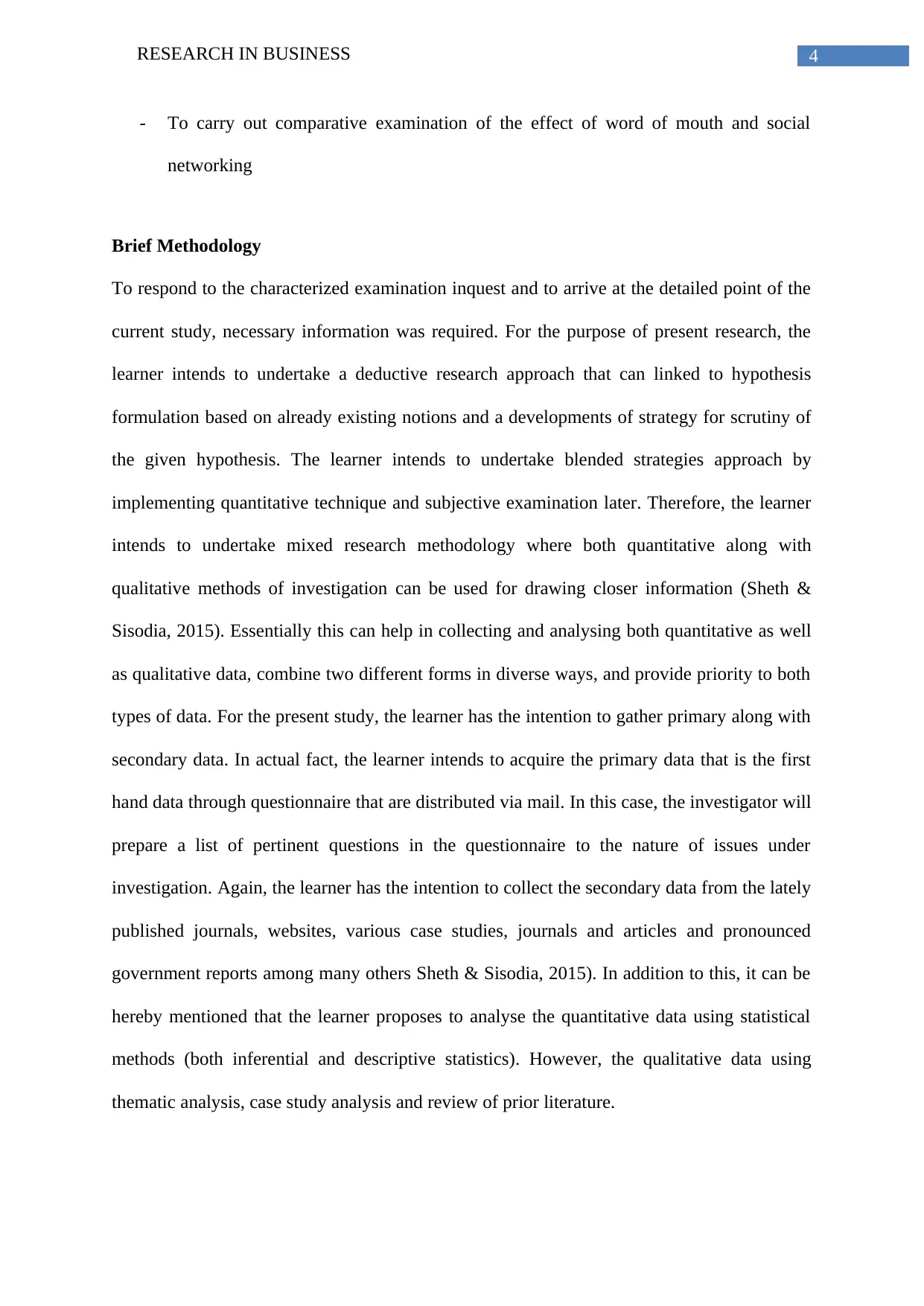
4RESEARCH IN BUSINESS
- To carry out comparative examination of the effect of word of mouth and social
networking
Brief Methodology
To respond to the characterized examination inquest and to arrive at the detailed point of the
current study, necessary information was required. For the purpose of present research, the
learner intends to undertake a deductive research approach that can linked to hypothesis
formulation based on already existing notions and a developments of strategy for scrutiny of
the given hypothesis. The learner intends to undertake blended strategies approach by
implementing quantitative technique and subjective examination later. Therefore, the learner
intends to undertake mixed research methodology where both quantitative along with
qualitative methods of investigation can be used for drawing closer information (Sheth &
Sisodia, 2015). Essentially this can help in collecting and analysing both quantitative as well
as qualitative data, combine two different forms in diverse ways, and provide priority to both
types of data. For the present study, the learner has the intention to gather primary along with
secondary data. In actual fact, the learner intends to acquire the primary data that is the first
hand data through questionnaire that are distributed via mail. In this case, the investigator will
prepare a list of pertinent questions in the questionnaire to the nature of issues under
investigation. Again, the learner has the intention to collect the secondary data from the lately
published journals, websites, various case studies, journals and articles and pronounced
government reports among many others Sheth & Sisodia, 2015). In addition to this, it can be
hereby mentioned that the learner proposes to analyse the quantitative data using statistical
methods (both inferential and descriptive statistics). However, the qualitative data using
thematic analysis, case study analysis and review of prior literature.
- To carry out comparative examination of the effect of word of mouth and social
networking
Brief Methodology
To respond to the characterized examination inquest and to arrive at the detailed point of the
current study, necessary information was required. For the purpose of present research, the
learner intends to undertake a deductive research approach that can linked to hypothesis
formulation based on already existing notions and a developments of strategy for scrutiny of
the given hypothesis. The learner intends to undertake blended strategies approach by
implementing quantitative technique and subjective examination later. Therefore, the learner
intends to undertake mixed research methodology where both quantitative along with
qualitative methods of investigation can be used for drawing closer information (Sheth &
Sisodia, 2015). Essentially this can help in collecting and analysing both quantitative as well
as qualitative data, combine two different forms in diverse ways, and provide priority to both
types of data. For the present study, the learner has the intention to gather primary along with
secondary data. In actual fact, the learner intends to acquire the primary data that is the first
hand data through questionnaire that are distributed via mail. In this case, the investigator will
prepare a list of pertinent questions in the questionnaire to the nature of issues under
investigation. Again, the learner has the intention to collect the secondary data from the lately
published journals, websites, various case studies, journals and articles and pronounced
government reports among many others Sheth & Sisodia, 2015). In addition to this, it can be
hereby mentioned that the learner proposes to analyse the quantitative data using statistical
methods (both inferential and descriptive statistics). However, the qualitative data using
thematic analysis, case study analysis and review of prior literature.
Paraphrase This Document
Need a fresh take? Get an instant paraphrase of this document with our AI Paraphraser
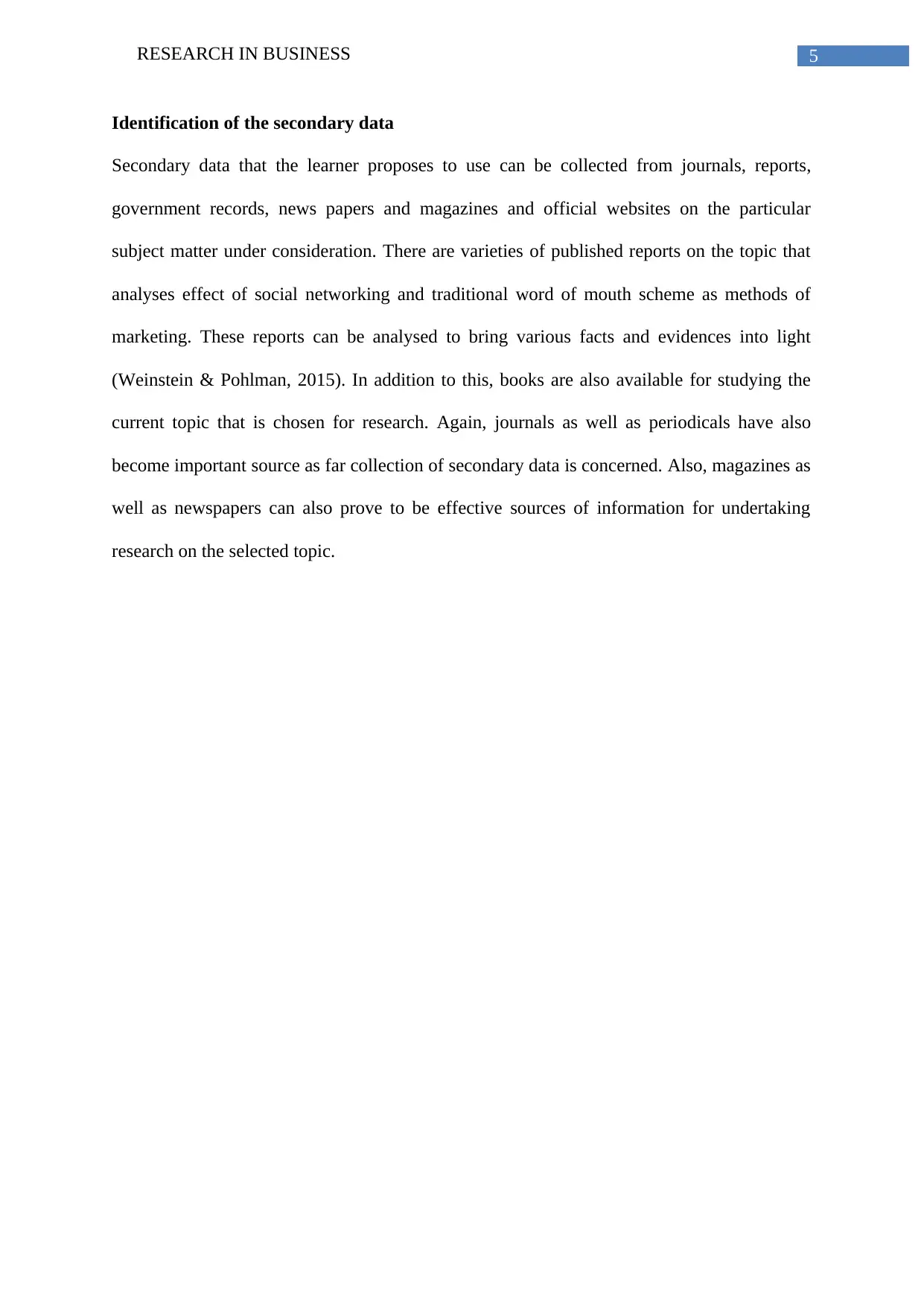
5RESEARCH IN BUSINESS
Identification of the secondary data
Secondary data that the learner proposes to use can be collected from journals, reports,
government records, news papers and magazines and official websites on the particular
subject matter under consideration. There are varieties of published reports on the topic that
analyses effect of social networking and traditional word of mouth scheme as methods of
marketing. These reports can be analysed to bring various facts and evidences into light
(Weinstein & Pohlman, 2015). In addition to this, books are also available for studying the
current topic that is chosen for research. Again, journals as well as periodicals have also
become important source as far collection of secondary data is concerned. Also, magazines as
well as newspapers can also prove to be effective sources of information for undertaking
research on the selected topic.
Identification of the secondary data
Secondary data that the learner proposes to use can be collected from journals, reports,
government records, news papers and magazines and official websites on the particular
subject matter under consideration. There are varieties of published reports on the topic that
analyses effect of social networking and traditional word of mouth scheme as methods of
marketing. These reports can be analysed to bring various facts and evidences into light
(Weinstein & Pohlman, 2015). In addition to this, books are also available for studying the
current topic that is chosen for research. Again, journals as well as periodicals have also
become important source as far collection of secondary data is concerned. Also, magazines as
well as newspapers can also prove to be effective sources of information for undertaking
research on the selected topic.
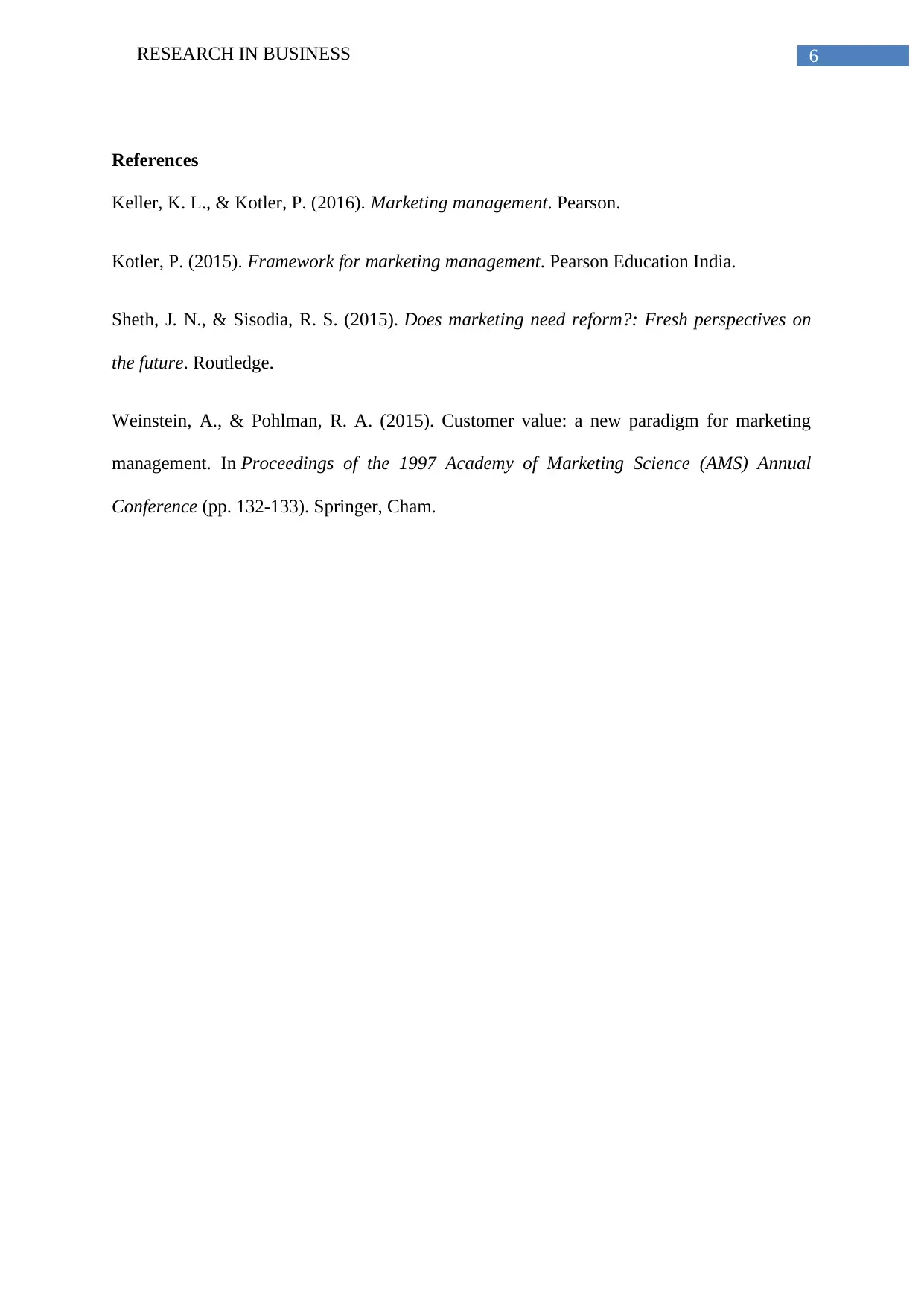
6RESEARCH IN BUSINESS
References
Keller, K. L., & Kotler, P. (2016). Marketing management. Pearson.
Kotler, P. (2015). Framework for marketing management. Pearson Education India.
Sheth, J. N., & Sisodia, R. S. (2015). Does marketing need reform?: Fresh perspectives on
the future. Routledge.
Weinstein, A., & Pohlman, R. A. (2015). Customer value: a new paradigm for marketing
management. In Proceedings of the 1997 Academy of Marketing Science (AMS) Annual
Conference (pp. 132-133). Springer, Cham.
References
Keller, K. L., & Kotler, P. (2016). Marketing management. Pearson.
Kotler, P. (2015). Framework for marketing management. Pearson Education India.
Sheth, J. N., & Sisodia, R. S. (2015). Does marketing need reform?: Fresh perspectives on
the future. Routledge.
Weinstein, A., & Pohlman, R. A. (2015). Customer value: a new paradigm for marketing
management. In Proceedings of the 1997 Academy of Marketing Science (AMS) Annual
Conference (pp. 132-133). Springer, Cham.
⊘ This is a preview!⊘
Do you want full access?
Subscribe today to unlock all pages.

Trusted by 1+ million students worldwide
1 out of 6
Related Documents
Your All-in-One AI-Powered Toolkit for Academic Success.
+13062052269
info@desklib.com
Available 24*7 on WhatsApp / Email
![[object Object]](/_next/static/media/star-bottom.7253800d.svg)
Unlock your academic potential
Copyright © 2020–2025 A2Z Services. All Rights Reserved. Developed and managed by ZUCOL.





